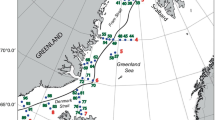Abstract
Our knowledge of the horizontal distribution of heavy metals in the open ocean with time and space is still very incomplete. Complementary to chemical water analyses suitable biological indicator species may be used to fill this gap. The pleuston organism Halobates micans was collected from 1966 to 1987 at 151 sampling stations of the tropical and subtropical Atlantic Ocean. The cadmium data from more than 1000 individuals analysed display a chemicaloceanographic meaningful distribution in surface waters and compare favourably to primary production values. Chemical analysis of individual plankton species offer a new tool for a better understanding of geochemical cycling of heavy metals in the ocean.
Similar content being viewed by others
Literature cited
Andersen, N. M., Polhemus, J. T. (1976). Water-striders (Hemiptera: Gerridae, Veliidae, etc.). In: Cheng, L. (ed.) Marine insects. North-Holland Publ. Comp., Amsterdam, p. 187–224
Berger, W. H., Fischer, K., Lai, C., Wu, G. (1987). Ocean productivity and organic carbon flux. Part I. Overview and maps of primary production and export production. SIO Ref. 87-30. San Diego
Boyle, E. A., Sclater, F., Edmond, J. M. (1976). On the marine geochemistry of cadmium. Nature, Lond. 263: 42–44
Bruland, K. W. (1980). Oceanographic distribution of cadmium, zinc, nickel and copper in the North Pacific. Earth planet. Sci. Lett. 47: 176–198
Bruland, K. W., Franks, R. P. (1983). Mn, Ni, Cu, Zn, and Cd in the western North Atlantic. In: Wong, C. S., Boyle, E. A., Bruland, K. W., Goldberg, E. D. (eds.) Trace metals in sea water. Plenum Press, New York, p. 395–414
Bull, K. R., Murton, R. K., Osborn, D., Ward, P., Cheng, L. (1977). High levels of cadmium in Atlantic seabirds and sea-skaters. Nature, Lond. 269: 507–509
Cheng, L. (1974). Notes on the ecology of the oceanic insect Halobates. Mar. Fish. Rev. 36: 1–7
Cheng, L. (1985). Biology of Halobates (Heteroptera: Gerridae). A. Rev. Ent. 30: 111–135
Cheng, L., Schulz-Baldes, M. (1981). Frequency and population composition of Halobates micans (Heteroptera: Gerridae) from the central and south Atlantic Ocean. “Meteor” Forsch. Ergeb. Series D 33: 17–21
Danielsson, L.-G., Magnusson, B., Westerlund, S. (1985). Cadmium, copper, iron, nickel and zinc in the north-east Atlantic Ocean. Mar. Chem. 17: 23–41
Hardy, J. T. (1982). The sea surface microlayer: biology, chemistry and anthropogenic enrichment. Prog. Oceanogr. 11: 307–328
Haury, L. R., Pieper, R. E. (1988). Zooplankton: scales of biological and physical events. In: Soule, D. F., Kleppel, G. S. (eds.) Marine organisms as indicators. Springer, New York, p. 35–72
Hempel, G., Weikert, H. (1972). The neuston of the subtropical and boreal Northeastern Atlantic Ocean. A review. Mar. Biol. 13: 70–88
Hentschel, E., Wattenberg, H. (1930). Plankton und Phosphat in der Oberflächenschicht des Südatlantischen Ozeans. Ann. Hydrogr. Maritime Meteorol. 58: 273–277
Kremling, K. (1985). The distribution of cadmium, copper, nickel, manganese, and aluminium in surface waters of the open Atlantic and European shelf area. Deep-sea Res. 32: 531–555
Kremling, K. (1989). Studies on the spatial and seasonal variability of dissolved cadmium, copper and nickel in north-east Atlantic surface waters. Mar. Chem.
Phillips, D. J. H. (1980). Quantitative aquatic biological indicators. Applied Science Publishers, London
Raymont, J. E. G. (1983). Plankton and productivity in the oceans. 2nd Edn. Vol. 2 — Zooplankton. Pergamon Press, New York
Reid, J. L., Brinton, E., Fleminger, A., Venrick, E. L., McGowan, J. A. (1978). Ocean circulation and marine life. In: Charnock, H., Deacon, G. (eds.) Advances in Oceanography. Plenum Press, New York, p. 65–130
Schulz-Baldes, M., Cheng, L. (1979). Uptake and loss of radioactive cadmium by the sea-skater Halobates robustus (Heteroptera, Gerridae). Mar. Biol. 52: 253–258
Schulz-Baldes, M., Cheng, L. (1980). Cadmium in Halobates micans from the central and south Atlantic Ocean. Mar. Biol. 59: 163–168
Schulz-Baldes, M., Cheng, L. (1981). Flux of radioactive cadmium through the sea-skater Halobates (Heteroptera: Gerridae). Mar. Biol. 62: 173–177
Tchernia, P. (1980). Descriptive regional oceanography. Pergamon Press. Oxford
Voituriez, B. (1981). Equatorial upwelling in the Eastern Atlantic: problems and paradoxes. In: Richards, F. A. (ed.) Coastal upwelling. American Geophysical Union, Washington D.C., p. 95–106
Wooster, W. S., Bakun, A., McLain, D. R. (1976). The seasonal upwelling cycle along the eastern boundary of the North Atlantic. J. Mar. Res. 34: 131–141
Author information
Authors and Affiliations
Additional information
Communicated by O. Kinne, Oldendorf/Luhe
Rights and permissions
About this article
Cite this article
Schulz-Baldes, M. The sea-skater Halobates micans: an open ocean bioindicator for cadmium distribution in Atlantic surface waters. Mar. Biol. 102, 211–215 (1989). https://doi.org/10.1007/BF00428282
Accepted:
Issue Date:
DOI: https://doi.org/10.1007/BF00428282




